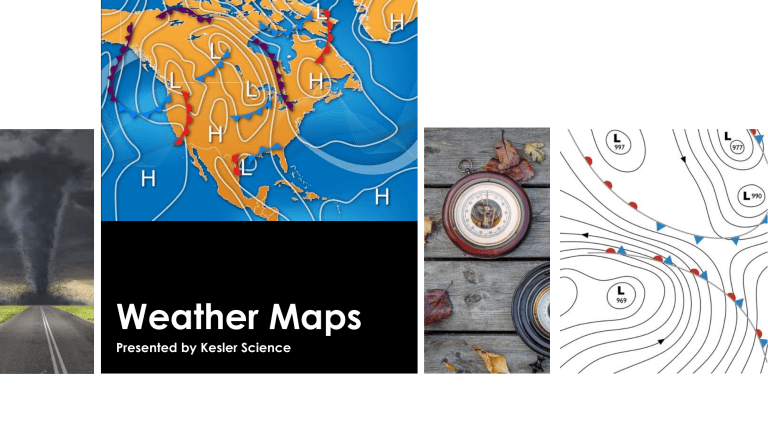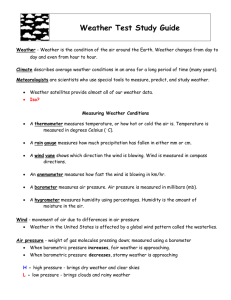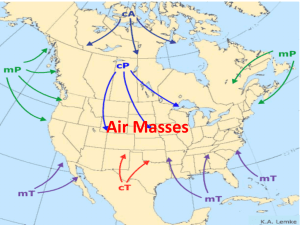3ExplanationWeatherMaps-1476293123766
advertisement

Weather Maps Presented by Kesler Science Essential Questions: 1. How can you use weather maps to explain global weather patterns and their influence on local weather? 2. How can you interpret high and low pressure areas as well as fronts on a weather map? Weather Maps • Pressure caused by the weight of air above an area • Pressure decreases with increasing height above Earth • A 1 square inch column of air measured from sea level to the top of the atmosphere weighs approximately 14.7 pounds © KeslerScience.com Gravity Atmospheric(Air)Pressure 1 sq. in. column of air 14.7 lbs Weather Maps Mercury Barometer Air Pressure • Measured with a barometer in millibars. • Average barometric pressure at sea level is 1013.25 millibars or 29.92 Hg (inches of mercury) • High pressure –creates greater pressure on the barometer • Low pressure - creates less pressure on the barometer © KeslerScience.com Quick Action – INB Template Title INB Template 1. 2. 3. © KeslerScience.com Cut out the Template Glue into notebook along narrow tab. Draw and color a picture of the symbol and describe the weather associated with it. Weather Maps High pressure H As air cools, it becomes more dense and sinks toward the Earth’s surface spinning clockwise. Low pressure L As air warms, it becomes less dense and rises above the Earth’s surface spinning counterclockwise. © KeslerScience.com Weather Maps High Pressure • Sunny, clear skies • Calm winds, spiral clockwise • Cool, dry air • Higher than normal - 30.5 Hg Low Pressure • Cloudy, stormy skies • Strong winds, spiral counterclockwise • Warm, moist air • Lower than normal - 28.9Hg © KeslerScience.com What weather occurs when a high pressure system moves into your area ? H L Weather Maps Isobars • A line connecting points of equal atmospheric pressure. • Measured in millibars mb • One millibars is equal to about .02953 inches of mercury. © KeslerScience.com Weather Maps Low Pressure in Storms Tornados 850 mb, 25.17 Hg Possibly lowest ever recorded © KeslerScience.com Hurricanes 882 mb, 26.05 Hg Lowest U.S. storm measured Weather Maps Air Masses • A large body of air that has relatively uniform temperature and humidity. • Originate •over land (Continental) •over water (Maritime). • Cold air masses tend to approach from N, NW or W. • Warm air masses tend to approach from S, SE or E. © KeslerScience.com Weather Maps H q © KeslerScience.com L Frontal Movement • Cooler air masses (H) are more dense and flows toward areas that are less dense, warm, and moist. (L). • High pressure areas move into low pressure areas. Weather Maps Front • The boundary between two air masses. • Classified by which type of air mass (cold or warm) is replacing the other. • Map symbols point in direction front is moving. Cold Warm Stationary Occluded © KeslerScience.com Weather Maps Cold Front • A cold air mass is replacing a warm air mass. • Air behind the front is colder and drier. • Pressure increases (H) • Moist air is pushed up over the cold air. • Showers and thunderstorms form along leading edge of front. © KeslerScience.com Weather Maps Warm Front • A warm air mass is replacing a cold air mass. • Air behind the front is warm and moist. • Pressure goes down (L) • Slow moving, gradual rise of warm air over cold air. • Widespread, continuous precipitation occurs along and ahead of the front. © KeslerScience.com Quick Action – Weather Maps Write About 1. Write a quick description of a cold and warm front. 2. Explain what the weather would be before, during and after the frontal passage over your city. © KeslerScience.com Weather Maps Stationary Front • A boundary between two different air masses, neither of which is strong enough to replace the other. • Light rain over several days © KeslerScience.com Weather Maps Occluded Front • Two cold air masses converge on a warm air mass. • Occurs when a fast moving cold front overtakes a warm front pushing it up and over cold air. • Thundershowers form along the front. • After frontal passage the sky is usually clear and dry. © KeslerScience.com Weather Maps Back Door Cold Front • Approaches from the east or northeast. • The term “back door” is most commonly used in the northeast U.S. when cool Atlantic maritime air moves in from the east and replaces warmer continental air. © KeslerScience.com Quick Action – Title • Stand up and find a partner. • Discuss what this map shows you. • Decide where you would draw in a fontal boundary. • Explain where and what type boundary it should be. • Describe the weather on both sides of the front. © KeslerScience.com H 39o 35o 40o 45o 39o L 75o 70o 75o 80o Quick Action – INB Template Title INB Template 1. 2. 3. © KeslerScience.com Cut out the Templates. Glue along the narrow tabs to make a flip book. Answer the questions and create your own map. Quick Action – INB Template Title INB Template 1. Cut out the Template 2. Glue on back of blank side. 3. Makes a flip book. 4. Define each instrument under flap. © KeslerScience.com Weather Maps Weather Instruments • Barometer (A) - measures atmospheric pressure in mb & Hg A • Anemometer (B) - measures wind speed in mph • Thermometer (C) - measures temperature in oC & oF © KeslerScience.com B C Weather Maps Weather Instruments • Weather Balloon (A) - carry instruments to high altitudes to measure pressure, temperature, humidity, and wind speed • Compass Rose (B) - helps determine wind direction when reading weather maps • Wind Vane (C) - measures wind direction as N,S,E,W © KeslerScience.com A B C Check for Understanding Can you… 1. Use a weather map showing high and low pressure and fronts to explain how global air movement affects local weather? © KeslerScience.com





